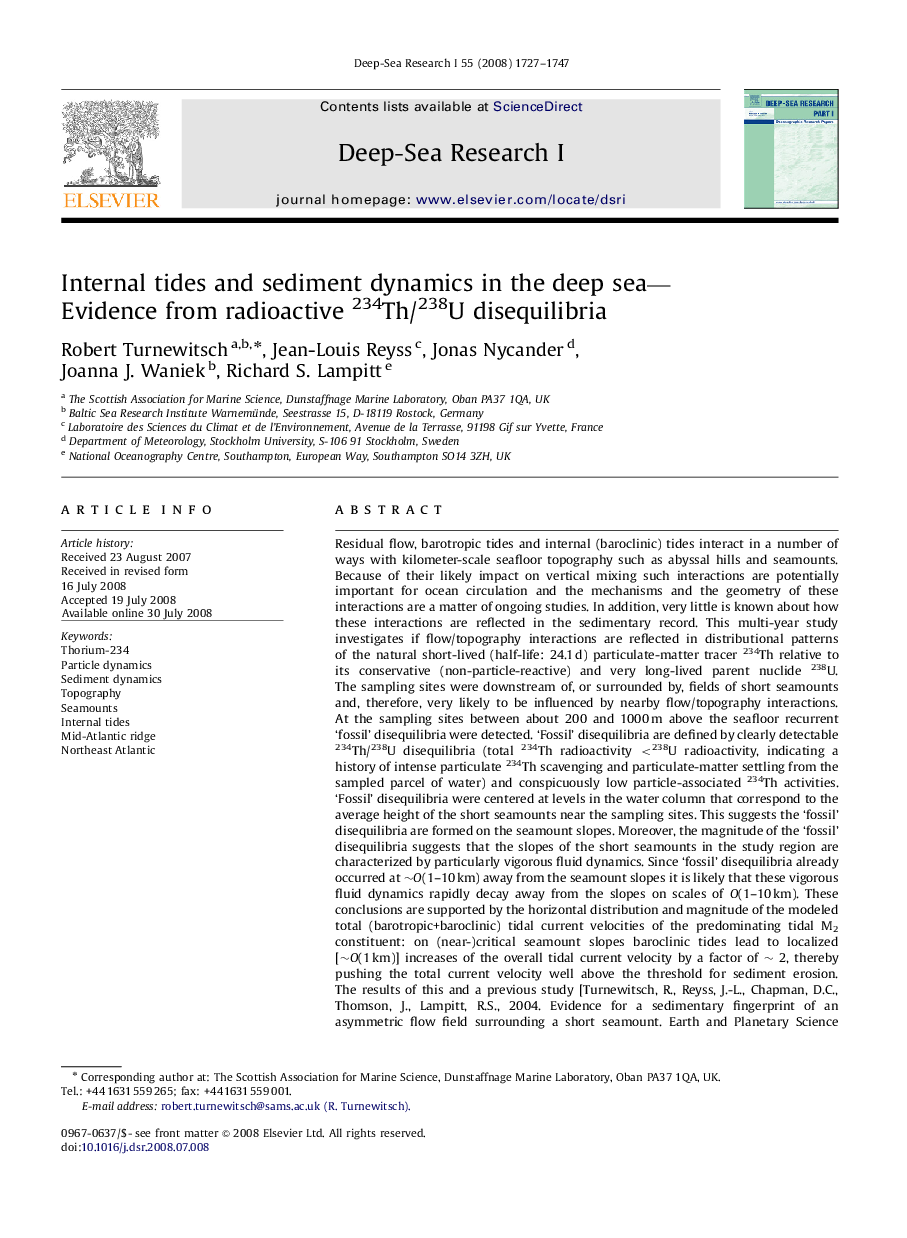| کد مقاله | کد نشریه | سال انتشار | مقاله انگلیسی | نسخه تمام متن |
|---|---|---|---|---|
| 4535153 | 1326087 | 2008 | 21 صفحه PDF | دانلود رایگان |

Residual flow, barotropic tides and internal (baroclinic) tides interact in a number of ways with kilometer-scale seafloor topography such as abyssal hills and seamounts. Because of their likely impact on vertical mixing such interactions are potentially important for ocean circulation and the mechanisms and the geometry of these interactions are a matter of ongoing studies. In addition, very little is known about how these interactions are reflected in the sedimentary record. This multi-year study investigates if flow/topography interactions are reflected in distributional patterns of the natural short-lived (half-life: 24.1 d) particulate-matter tracer 234Th relative to its conservative (non-particle-reactive) and very long-lived parent nuclide 238U. The sampling sites were downstream of, or surrounded by, fields of short seamounts and, therefore, very likely to be influenced by nearby flow/topography interactions. At the sampling sites between about 200 and 1000 m above the seafloor recurrent ‘fossil’ disequilibria were detected. ‘Fossil’ disequilibria are defined by clearly detectable 234Th/238U disequilibria (total 234Th radioactivity <238U radioactivity, indicating a history of intense particulate 234Th scavenging and particulate-matter settling from the sampled parcel of water) and conspicuously low particle-associated 234Th activities. ‘Fossil’ disequilibria were centered at levels in the water column that correspond to the average height of the short seamounts near the sampling sites. This suggests the ‘fossil’ disequilibria are formed on the seamount slopes. Moreover, the magnitude of the ‘fossil’ disequilibria suggests that the slopes of the short seamounts in the study region are characterized by particularly vigorous fluid dynamics. Since ‘fossil’ disequilibria already occurred at ∼O(1–10 km) away from the seamount slopes it is likely that these vigorous fluid dynamics rapidly decay away from the slopes on scales of O(1–10 km). These conclusions are supported by the horizontal distribution and magnitude of the modeled total (barotropic+baroclinic) tidal current velocities of the predominating tidal M2 constituent: on (near-)critical seamount slopes baroclinic tides lead to localized [∼O(1 km)] increases of the overall tidal current velocity by a factor of ∼ 2, thereby pushing the total current velocity well above the threshold for sediment erosion. The results of this and a previous study [Turnewitsch, R., Reyss, J.-L., Chapman, D.C., Thomson, J., Lampitt, R.S., 2004. Evidence for a sedimentary fingerprint of an asymmetric flow field surrounding a short seamount. Earth and Planetary Science Letters 222(3–4), 1023–1036] show that kilometer-scale flow/topography interactions leave a marine geochemical imprint. This imprint may help develop new sediment proxies for the reconstruction of past changes of fluid dynamics in the deep sea, including residual and tidal flow. Sedimentary records controlled by kilometer-scale seafloor elevations are promising systems for the reconstruction of paleo-changes of deep-ocean fluid dynamics. For the sediment-based reconstruction of paleo-parameters other than physical oceanographic ones it may be advisable to avoid kilometer-scale topography altogether.
Journal: Deep Sea Research Part I: Oceanographic Research Papers - Volume 55, Issue 12, December 2008, Pages 1727–1747